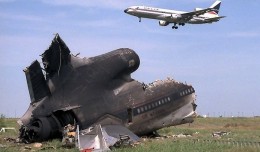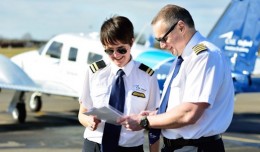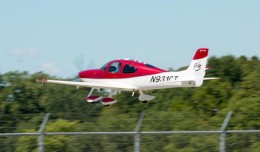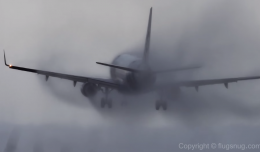(Editor’s Note: This week for Throwback Thursday, we go back to May, 2011 and Columnist Justin Schlechter’s telling of an aviation horror story. It would seem the spirits are alive and well in the skies over Southern Alaska this time of year.)
Blackness. There is nothing out there, not a town, not a person. Not a flicker of light to be seen for hundreds of miles. Just Blackness. There is no moon looking down upon us but something lurks in the darkness. The vastness of the Northwest Territory at 3:30 in the morning is a lonely place for anyone, especially the flight crew on this all-nighter to the northwest corner of the North American continent.
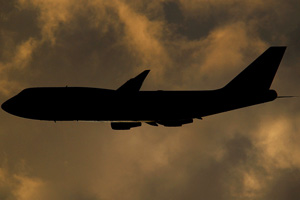
Flying into the night presents a new set of dangers and mystery ahead of you. (Photo by Gordon Gebert Jr.)
The coffee is getting cold and the late night sodium fest has long been digested, leaving us in a dark cockpit with not much else to keep our minds in the game. A fuel check here, a flip of a chart, there. We are too tired for conversation and the drudgery of all night flying is taking its toll. Anything to stay awake at this point. Dry eyes and dry air contribute to our discomfort. Only two hours until our bodies drop into a hotel bed. We are in that stage of flight where the adrenaline has worn off from departure and we have run out of tasks to really keep our minds sharp. Soaring over the darkness of Canada could not come at a worse time.
There is not one single indication of motion except for the miles ticking off on the FMC as well as the smooth ever moving line of magenta that pierces the center of the Navigation Display. It is perfectly still, perfectly dark, and perfectly black out there on this cold October night. On most nights like this the Northern Lights keep us company, with their awe inspiring greens, blues, and reds providing the entertainment, but it appears that they have taken the night off. At this point, we cannot wait to join them.
As we sit here, I get a sense of uneasiness. What is that? We cannot see anything, but a ghost in the darkness is upon us. The nose of the aircraft seems to shift slightly down, and then….wait for it…….BAM! A jolt of turbulence awakens us from our stupor and then just as quickly the night air smoothes out again. I cannot explain it, but it seems like we can sense the turbulence coming before it ever hits us. Like a sixth sense, except this one involves ‘seeing’ turbulence and not dead people like the appropriately named Hollywood feature. Our B747 handles the jolt like an SUV handles a small pothole. A thump in the night, and back to normal and the return to our struggle with staying awake in this vacuum of nothingness.
With a quick glance down, I pull up a new ATIS for our arrival and within a few seconds, the printer gives us an update. We can expect scattered clouds, good visibility and winds out of the north at about five knots for landing. Not too bad I think, but the Ghosts of October have a funny way of haunting us, especially in the autumn Alaskan night.
•••
Fighting a 100-knot headwind is more of a psychological battle than anything else. A flight that is seven hours long into a headwind takes forever, but the flight that is seven hours long due to a 100-knot tailwinds flies past in a flash! We’ve been paddling upstream tonight which when combined with the darkness and fatigue is the perfect trifecta of misery on our flight tonight. Our descent preparations are long over and as we pass our descent point, I notice that our headwind has shifted to a crosswind out of the south. An Aleutian Low is stationed out over the Gulf of Alaska tonight so it is no surprise. Our groundspeed inches up and as we begin the descent my bed feels all that much closer. Our state of fatigue has dropped off a bit as the cockpit is more lively now, but it is still black as death outside the windscreen as we descend to cross YESKA at 11,000 feet.
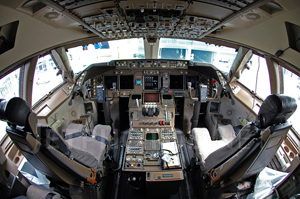
The front office of a 747 can get hectic in a hurry. (Photo by Michael C. Sikoutris)
Descending out of FL300 we get an ominous message from ATC. “Be advised, a B737 has reported severe turbulence from FL200 to 3,000AGL about 10 minutes ago.” Wonderful. This is not surprising for this area during the fall months. The low pressure system over the gulf is incredibly strong this time of year. It is not uncommon for the winds aloft to reach speeds up to 100 knots as low as 6,000 feet out of the southeast. Coupled with the inhospitable terrain stretching south and east of Anchorage, the resulting topography is a breeding ground for autumn’s evil spirits. We buckle up and slow our ship to turbulence penetration speed so as to battle what haunts us in the night.
The rough air shouldn’t be too bad considering the report came from a 73, I think to myself. Famous last words. I take a glance once again at the ATIS and realize I missed one small but very important detail from earlier. “WS010/18050KT” has been glossed over in the remarks section. Windshear at 1000 feet from the south at 50 knots. An incredible shear awaits us. There is evil in the air tonight and we are going to tackle it head on.
We descend through FL200 and at first nothing. Maybe the report was wrong. Another call from ATC breaks the silence. “Be advised, a company 747 has just reported severe turbulence as well, down to 1000 feet.” There is no way we will luck out tonight. What better time to deal with the wickedness that an October night can bring to southern Alaska. Tired, cranky, and dehydrated, it is time to battle the beast. It is nights like this that we earn our pay.
It begins. A gentle rumble at first and then nothing. It is as if Mother Nature has decided to mess with us. Just bring it on already. She pokes and prods and then out in the darkness, it is as if we are broadsided by a freight train! The airplane yaws severely to the left and we roll to about fifteen degrees of bank! At least that is what I think the instruments are saying, as I cannot read them! We literally are being tossed about like a kite on a gusty day. How is this be possible in a ship so big? I’ve never heard the sounds of flexing metal in an airliner until right now. I can feel the flexing of the wings reverberating back into the airframe! It takes all of our might to keep the airspeed within limits and we ensure that our Pratt and Whitneys get a workout in the process. As we descend, demons battle with the airframe with all their might! The airframe rolls, yaws, and pitches in violent outbursts attempting to sling them from the exterior but it is no use. We cannot shed the onslaught of foulness nature has thrown at us tonight.
Through the cacophony of flexing metal and rumbling airframe, we overhear our company aircraft. “Anchorage Approach, be advised we will attempt one more approach and then divert to Fairbanks if necessary.” One more? They must have surely had a hard windshear warning causing them to go-around. We have barely enough fuel to make Fairbanks after our first attempt! It is going to be one or nothing tonight in Anchorage. If we can’t make it in, we head straight towards the heart of Alaska for a tech stop. At this hour of the night and with the airplane battling to stay upright, we don’t say it out loud on the flightdeck, but internally both of us dread the thought.

The discomfort of heavy turbulence and windshear is only slightly easier when your passenger is cargo. (Photo by Brian Futterman)
The turbulence is unrelenting but as the aircraft bucks and heaves I grow increasingly confident in what amazing strength the ship has. I’ve never experienced air like this continuously for such a lengthy amount of time, despite our hurried attempts to get lower! Descending out of 8,000 feet abeam the airport on downwind, the violence gets even worse. We need to begin reducing speed but we can hardly control it in the first place! We are experiencing plus and minus 30 knots of airspeed the whole way down! We somehow eventually manage to get her lined up on the localizer and configured for landing. With a clearance to land, our next battle approaches as we exit these ferocious winds at 1,000 feet and attempt to keep the airspeed up through the shear zone. With only five knots of wind at the surface, it will no doubt be rough.
Finally, with one last violent attempt at winning the battle, our jumbo throws October’s foes from her wingtips and in a violent decreasing shear, the engines strain to keep her moving through the air, all the while tiptoeing the line of aerodynamic sanity. We make it through! We still get a few jolts the rest of the way down, but the battle is mostly over. As the mains settle onto Runway 07L, I am amazed that we did not get a hard windshear warning which would have resulted in a go-around. To have to deal with a diversion after a night like this would have been torture. Especially so, since legally we still would have more than enough duty time to fuel up and go back to Anchorage! We would do it because that is what professionals do, but it would not be pleasant. As we taxi in, we finally see our sister ship touchdown after their second approach. Thankfully, they made it in as well. Relieved that our flight is over I realize that it is time for bed, although now I am running on 100% adrenaline. The ride to the hotel and a hot shower will cure that, and before you know it I’m under the covers and fast asleep.
•••
The following afternoon, my coworker and I were joined at a groggy lunch by the crew of the preceding company aircraft that had executed the go-around. “Roughest ride I’ve ever seen! We had to do a windshear go-around at 1,200 feet and let me tell you it was eye opening to say the least!” exclaimed the captain of the ship. “You just never know what October will bring up here! It could be beautiful or a nightmare and half the time the forecasts are completely off! This sort of thing happens every few years up here. Always in October!” he continued. Lunch was finished and the shop talk continued as it most always does. It was here at the table, talking about what we did, what we learned, and how we could have done things differently that really brought the prior evenings events to a close. Sitting in a dark cockpit in the depths of the night and being brought back to consciousness by Mother Nature is a pretty remarkable feat. Being able to walk away from the resulting chaos unscathed is what makes us professional airmen.
Luckily for us, our flight ended quite unremarkably. However, the low pressure system would hang around the Gulf of Alaska for a few more days. Anchorage airspace had continuous severe turbulence during that time and at one point over eighteen airliners from all over the world had diverted to Fairbanks because the ride had become too treacherous. You just never know what an autumn night will throw at you in the great State of Alaska, but one thing is for sure, when the Ghosts of Octobers Past come to haunt your flight deck, you had most certainly be ready for anything.
NYCAviation Columnist Justin Schlechter is a First Officer for an international airline and lives with his family on Long Island, New York. You can read more of his writing on his Positive Rate blog.




